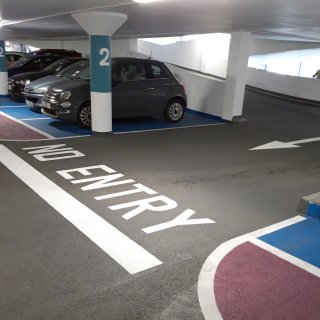Protecting our concrete & waterproofing our structures
A waterproofing membrane is described as 'a thin layer of water-tight material that is laid over a surface'. This layer is continuous and does not allow water to pass through it. These membranes are composed of thin layers of waterproof material. Most are about 2 to 4mm thick. There are essentially 2 types of membranes, sheet based membranes and liquid applied membranes. Ideally, a waterproofing membrane should be strong, flexible, tear-resistant and elastic so that it can stretch to cover cracks and also move with the building.
CRL use mostly liquid applied barrier membranes (although we do lay sheet based membranes) to exclude water from decks and roofs. These membranes provide a fully bonded, seemless, seal over the substrate which eliminates the risk of water tracking underneath. We are able to apply membranes to balconies, car park decks and roofs with non-slip finished surfaces in compliance with current regulations. These materials can sometimes be applied over existing waterproofing systems to reduce costs and the risk of water penetration. The preferred option is to remove the existing membranes, prepare the exposed surface and apply the new membrane.
We also use membranes for tank linings primarily in the water and wastewater sectors to protect the concrete surface and reduce leakage. For potable water tanks the membranes are approved by the Drinking Water Inspectorate (DWI) and are generally epoxy resins, polyurethane or cementitious based materials. For wastewater applications the coatings are required to protect the concrete from the acidic conditions so we often use epoxy resin coatings.
We are approved applicators for all the leading material suppliers in Australia and it is important to select the correct material for each specific application taking into account the environmental conditions both during application and service life.Some membranes are rigid membranes such as epoxy resins and others are able to flex and bridge any subsequent movement or cracking such as polyurethanes.
The successful application of waterproof membranes and tank linings requires rigourous quality control procedures. At CRL we have developed specific application control procedures based on our 65 years' experience in the industry. During the applications we monitor air and substrate temperatures, air humidity, dewpoint, material batch numbers and mixing procedures. Correct curing in accordance with the manufacturer's instructions is also a critical element of the works.
With CRL you can be assured that the correct membrane used will deliver your objectives and the surface preparation, membrane application and curing will be quality controlled for a successful outcome.
Examples of recent work in Australia include sheet membranes applied in the new deep station basements for the Melbourne Metro and liquid applied deck waterproofing membranes applied to the West Gate Bridge in Melbourne.
Related Projects

"Membranes keep water out and protect the concrete. CRL have the experience and reputation to successfully install waterproof membranes and tank linings that work as they should."







